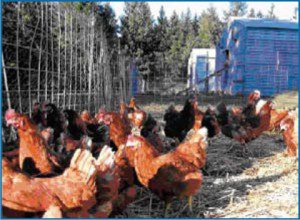Range Requirements

 The Animal Care Standards for laying hens do not require that hens have access to range. When range is provided, the following standards must be met.
The Animal Care Standards for laying hens do not require that hens have access to range. When range is provided, the following standards must be met.
Outdoor Area
The outdoor area must be designed and managed to ensure that the land around the house does not become damaged, contaminated, or sodden. Chickens with access to range must have access to a well-drained area for resting while outside the building.
Exits
Hens with access to range area must have sufficient exit areas appropriately distributed around the building to ensure that all hens have ready access to the range, and each exit area must allow the passage of more than one hen at a time.
Vegetative Cover for Range Area
A cover of living vegetation should be maintained over the grazing area, with active management of damaged ground. Land used for cropping (except grass or hay) is not regarded as acceptable vegetation and must be excluded from calculations for grazing space allowance.
Size of Range Area
In systems where birds are primarily managed on range, they can be called Pasture-Raised. The minimum space required is 2.5 acres for every thousand birds. Additionally, the perimeter of the range should be within 400 yards of the closest door.
In systems where birds are offered free choice to be inside or outside during the day, it is referred to as Free-Range. In this system they must have access to a minimum of 2 square feet of range area per bird.
Parasite Control
When there is a risk of build up of parasites or pathogens on range land, rotational grazing or other disease control measures must be applied.
Overhead Cover
Hens with access to range are must have access to overhead cover to reduce regular fear reactions to overhead predators.
Shelter
To protect hens from excessively cold temperatures or other adverse weather conditions, a shelter must be accessible that is of sufficient size to accommodate all hens. The shelter must also provide sufficient protection from wind, rain, and snow. In areas where excessive heat may be a problem, a shaded area that has sufficient space so that hens do not have to crowd together, risking further heat stress, must be accessible to the birds.




Range Requirements
Outdoor Area
The outdoor area must be designed and managed to ensure that the land around the house does not become damaged, contaminated, or sodden. Chickens with access to range must have access to a well-drained area for resting while outside the building.
Exits
Hens with access to range area must have sufficient exit areas appropriately distributed around the building to ensure that all hens have ready access to the range, and each exit area must allow the passage of more than one hen at a time.
Vegetative Cover for Range Area
A cover of living vegetation should be maintained over the grazing area, with active management of damaged ground. Land used for cropping (except grass or hay) is not regarded as acceptable vegetation and must be excluded from calculations for grazing space allowance.
Size of Range Area
In systems where birds are primarily managed on range, they can be called Pasture-Raised. The minimum space required is 2.5 acres for every thousand birds. Additionally, the perimeter of the range should be within 400 yards of the closest door.
In systems where birds are offered free choice to be inside or outside during the day, it is referred to as Free-Range. In this system they must have access to a minimum of 2 square feet of range area per bird.
Parasite Control
When there is a risk of build up of parasites or pathogens on range land, rotational grazing or other disease control measures must be applied.
Overhead Cover
Hens with access to range are must have access to overhead cover to reduce regular fear reactions to overhead predators.
Shelter
To protect hens from excessively cold temperatures or other adverse weather conditions, a shelter must be accessible that is of sufficient size to accommodate all hens. The shelter must also provide sufficient protection from wind, rain, and snow. In areas where excessive heat may be a problem, a shaded area that has sufficient space so that hens do not have to crowd together, risking further heat stress, must be accessible to the birds.